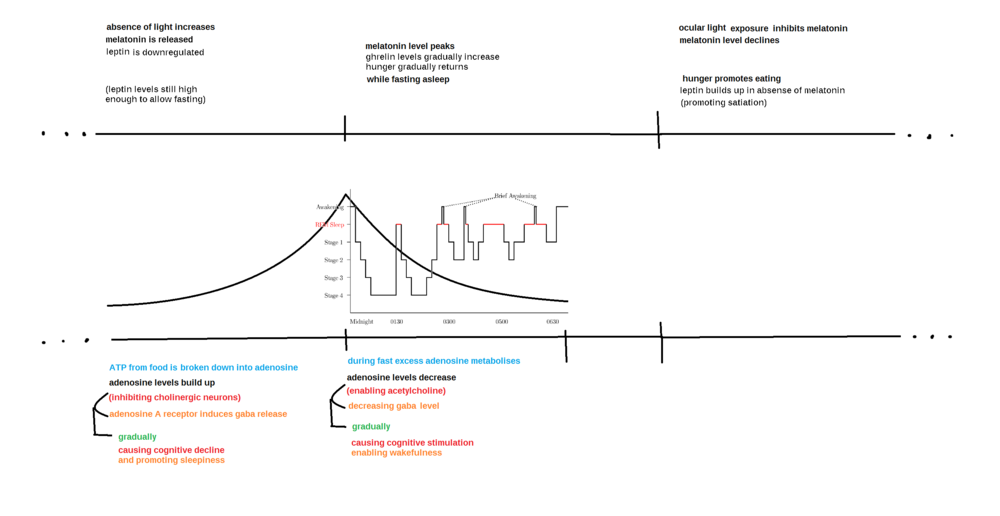Talk:Sleep-wake cycle
bear with me I'm sorting this out
http://web.mst.edu/~rhall/neuroscience/03_sleep/sleepneuro.pdf
http://www.ncbi.nlm.nih.gov/pmc/articles/PMC3362278/ Adenosine has been proposed as an endogenous homeostatic sleep factor that accumulates during waking and inhibits wake-active neurons to promote sleep. It has been specifically hypothesized that adenosine decreases wakefulness and promotes sleep recovery by directly inhibiting wake-active neurons of the basal forebrain (BF), particularly BF cholinergic neurons.
https://en.wikipedia.org/wiki/Nucleus_basalis_of_Meynert These cholinergic neurons have a number of important functions in particular with respect to modulating the ratio of reality and virtual reality components of visual perception. Smythies, J. (2009) Philosophy, Perception and Neuroscience. Philosophy 38, 638–51.
https://en.wikipedia.org/wiki/Visual_cortex#Primary_visual_cortex_.28V1.29 It is highly specialized for processing information about static and moving objects and is excellent in pattern recognition.
https://en.wikipedia.org/wiki/Ganzfeld_effect The effect is the result of the brain amplifying neural noise in order to look for the missing visual signals.[2] Eva Schindling "Amplify the Neural Noise" Web. 13 Oct. 2010 <http://www.evsc.net/research/amplify-the-neural-noise> The noise is interpreted in the higher visual cortex, and gives rise to hallucinations.[3] Dunning, Alan, and Paul Woodrow. "ColourBlind: Machine Imagination, Closed Eye Hallucination and the Ganzfeld Effect."2010. Web. 3 Dec. 2013. <http://www.academia.edu/455637/ColourBlind_Machine_Imagination_Closed_Eye_Hallucination_and_the_Ganzfeld_Effect>.
https://en.wikipedia.org/wiki/Nucleus_basalis_of_Meynert When a new potentially important stimulus is received, the Nucleus Basalis is activated. The axons it sends to the visual cortex provide collaterals to pyramidal cells in layer IV (the input layer for retinal fibres) where they activate excitatory nicotinic receptors and thus potentiate retinal activation of V1.[2] Yu AJ, Dayan P (May 2005). "Uncertainty, neuromodulation, and attention". Neuron. 46 (4): 681–92. doi:10.1016/j.neuron.2005.04.026. PMID 15944135.
http://www.ncbi.nlm.nih.gov/pubmed/10366002 GABA release from suprachiasmatic nucleus terminals is necessary for the light-induced inhibition of nocturnal melatonin release in the rat.
http://www.ncbi.nlm.nih.gov/pmc/articles/PMC3073841/
Endogenous GABA levels in the pontine reticular formation are greater during wakefulness than during REM sleep
http://www.ncbi.nlm.nih.gov/pubmed/15748171 An adenosine A receptor agonist induces sleep by increasing GABA release in the tuberomammillary nucleus to inhibit histaminergic systems in rats.
http://www.ncbi.nlm.nih.gov/pmc/articles/PMC3362278/ Adenosine inhibits glutamatergic input to basal forebrain cholinergic neurons
https://en.wikipedia.org/wiki/Melatonin
Blue light, principally around 460 to 480 nm, suppresses melatonin,[75] proportional to the light intensity and length of exposure. Until recent history, humans in temperate climates were exposed to few hours of (blue) daylight in the winter; their fires gave predominantly yellow light.[citation needed] The incandescent light bulb widely used in the 20th century produced relatively little blue light.[76] Light containing only wavelengths greater than 530 nm does not suppress melatonin in bright-light conditions.[77] Wearing glasses that block blue light in the hours before bedtime may decrease melatonin loss. Use of blue-blocking goggles the last hours before bedtime has also been advised for people who need to adjust to an earlier bedtime, as melatonin promotes sleepiness.[78]
also "During the night, melatonin regulates leptin, lowering its levels."
Kus I, Sarsilmaz M, Colakoglu N, Kukne A, Ozen OA, Yilmaz B, Kelestimur H (2004). "Pinealectomy increases and exogenous melatonin decreases leptin production in rat anterior pituitary cells: an immunohistochemical study". Physiol Res. 53 (4): 403–8. PMID 15311999.
